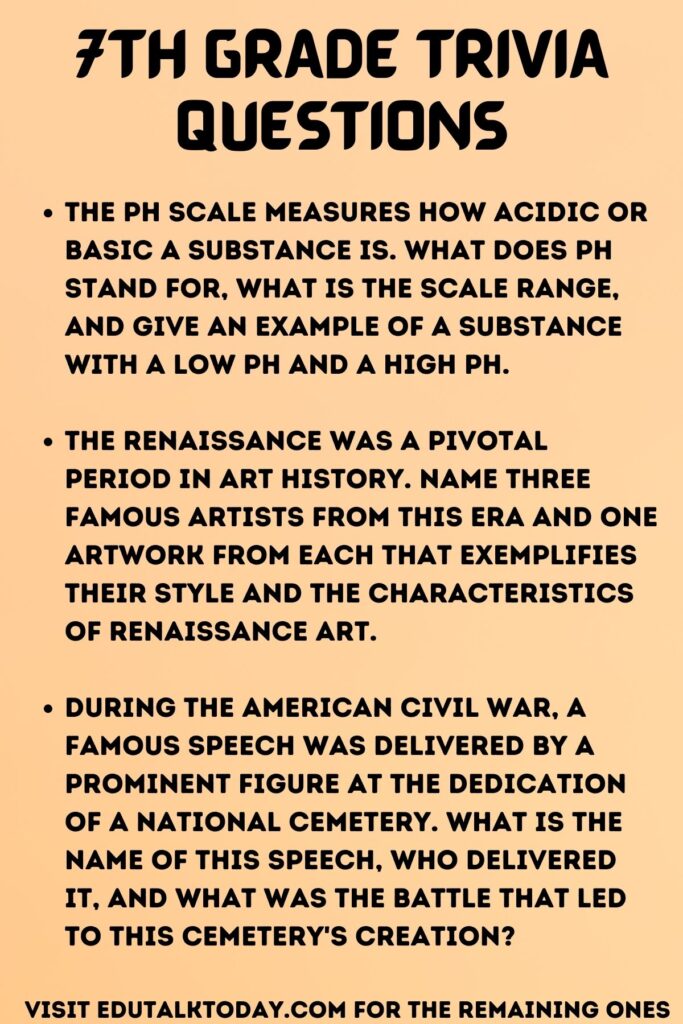35 7th Grade Trivia Questions

Looking for an amazing list of trivia questions for 7th graders?
Designed specifically for them, these questions cover topics relevant to their curriculum and general knowledge, making learning interactive and enjoyable.
Whether you’re looking for a way to review before a test, to host a classroom trivia challenge, or just to enjoy some educational fun at home, these trivia questions are sure to provide an entertaining and informative experience.
So, let’s dive in and see how much you know!
7th Grade Trivia Questions
- Astronomy: Located in the constellation of Ursa Major, a particular galaxy is known for its proximity to our own Milky Way and its spiral shape. What is the name of this galaxy, and why is it significant in terms of our understanding of the universe?
- History: During the American Civil War, a famous speech was delivered by a prominent figure at the dedication of a national cemetery. What is the name of this speech, who delivered it, and what was the battle that led to this cemetery’s creation?
- Biology: The process of photosynthesis is vital for life on Earth. Explain what photosynthesis is, naming the two main stages of this process and the specific organelle within plant cells where it occurs.
- Geography: The Nile River is famous for being the longest river in the world. What countries does it flow through, and why has it been historically significant for civilizations like ancient Egypt?
- Mathematics: The Fibonacci sequence is a series of numbers where each number is the sum of the two preceding ones, usually starting with 0 and 1. Can you list the first ten numbers in this sequence and explain its appearance in nature?
- Literature: William Shakespeare, an English playwright, wrote many plays that are still celebrated today. Name one of his tragedies and describe its main plot, including the protagonist’s conflict.
- Art: The Renaissance was a pivotal period in art history. Name three famous artists from this era and one artwork from each that exemplifies their style and the characteristics of Renaissance art.
- Science: In the periodic table, elements are arranged based on their atomic number. What element is represented by the atomic number 14, and what are some common uses of this element in everyday life?
- Technology: The Internet has transformed modern life. Discuss its origins, naming the initial project that led to its development, and explain how it has evolved to play a critical role in today’s society.
- Physics: Isaac Newton’s laws of motion are fundamental in physics. Describe his three laws of motion and give a real-world example of each.
- World Geography: The Amazon Rainforest, often referred to as the “lungs of the Earth,” spans several countries in South America. Name at least three of these countries and explain the significance of the Amazon Rainforest to global ecology.
- Chemistry: The pH scale measures how acidic or basic a substance is. What does pH stand for, what is the scale range, and give an example of a substance with a low pH and a high pH.
- World History: The Silk Road was an ancient network of trade routes connecting the East and West. What were the main goods traded along the Silk Road, and how did it impact the cultures it connected?
- Language Arts: Haiku is a form of traditional Japanese poetry. Describe the structure of a haiku and explain what themes are commonly explored in this poetic form.
- Music Theory: The concept of major and minor scales is fundamental in music. Describe the difference between a major scale and a minor scale, and give an example of a song in a major key and a song in a minor key.
- Environmental Science: Climate change is a significant issue facing our planet. What are the main causes of climate change, and what are some ways individuals can help reduce its impact?
- Astronomy: Our solar system consists of eight planets. Name them in order from the sun and identify one unique feature or fact about each planet.
- Mathematics: Pythagoras’ theorem is a fundamental principle in geometry. State the theorem and provide an example of a real-life situation where this theorem could be applied.
- Computer Science: Alan Turing is considered one of the fathers of computer science. What was his significant contribution during World War II, and how does his work continue to impact computing today?
- Art History: The Mona Lisa is one of the most famous paintings in the world, created by Leonardo da Vinci. Describe what makes this painting so unique and why it has become so iconic in art history.
- Physics: The concept of gravity was revolutionized by Sir Isaac Newton. Explain how his theory of gravity differed from previous beliefs and how it changed our understanding of the universe.
- World Literature: Homer’s “The Odyssey” is a classic piece of ancient Greek literature. Briefly summarize the plot and explain its significance in the context of Greek culture and mythology.
- Geography: The Himalayas are the highest mountain range in the world. Name at least three countries that this range spans and discuss the importance of the Himalayas to the local ecosystems and cultures.
- Biology: The human body has several vital organs. Name three of these organs and describe their primary functions in maintaining life.
- Chemistry: The Periodic Table organizes elements based on certain properties. Describe the trends in atomic radius and electronegativity across the Periodic Table.
- Environmental Science: The Great Barrier Reef off the coast of Australia is the world’s largest coral reef system. Discuss the ecological significance of coral reefs and the threats they face due to environmental changes.
- Mathematics: The concept of probability is essential in mathematics. Define probability and give an example of a simple probability calculation in a real-world scenario.
- Astronomy: The theory of the Big Bang explains the origin of the universe. What does this theory propose, and what are some key pieces of evidence that support it?
- Ancient Civilizations: The Egyptian pyramids are some of the most iconic architectural structures in history. How were they constructed, and what was their primary purpose in ancient Egyptian society?
- Environmental Science: The concept of a carbon footprint is crucial in understanding environmental impact. Define what a carbon footprint is and suggest ways an individual can reduce theirs.
- World Languages: The Chinese language is known for its unique writing system. What are the two main types of Chinese characters, and how does the language differ from alphabetic systems like English?
- Physics: The concept of a black hole is a fascinating topic in astrophysics. Explain what a black hole is and what happens at the event horizon of a black hole.
- Mathematics: The area of a circle is an important concept in geometry. State the formula for calculating the area of a circle and describe a practical situation where this calculation would be necessary.
- Chemistry: The states of matter (solid, liquid, gas) are fundamental concepts. Describe what distinguishes each state at a molecular level, and give an example of a substance that can exist in all three states under normal Earth conditions.
- History: The Industrial Revolution was a period of major industrialization that took place during the 18th and 19th centuries. Describe the major changes that occurred during this period and how they impacted society.
Answers
- The Andromeda Galaxy. It is significant because it’s the nearest spiral galaxy to the Milky Way and is on a collision course with our galaxy, expected to merge in about 4 billion years.
- The Gettysburg Address, delivered by President Abraham Lincoln. It followed the Battle of Gettysburg, a pivotal fight in the Civil War.
- Photosynthesis is the process by which plants convert light energy into chemical energy. The two stages are the Light-Dependent Reactions and the Calvin Cycle, occurring in the chloroplasts.
- The Nile flows through eleven countries, including Egypt, Sudan, and Ethiopia. It has been significant for providing fertile land for agriculture in Egypt’s desert landscape.
- The first ten numbers are 0, 1, 1, 2, 3, 5, 8, 13, 21, 34. This sequence appears in various natural phenomena, including the arrangement of leaves on a stem and the pattern of a nautilus shell.
- “Hamlet” is one such tragedy. It revolves around Prince Hamlet’s quest for revenge against his uncle Claudius, who has murdered Hamlet’s father, taken the throne, and married Hamlet’s mother.
- Leonardo da Vinci (“Mona Lisa”), Michelangelo (“David”), and Raphael (“School of Athens”). Their works showcase realism, focus on humanism, and use of perspective.
- Silicon, with the symbol Si. It is widely used in semiconductors and computer chips, as well as in solar panels and various forms of glass and concrete.
- The origins of the Internet trace back to ARPANET, a project by the U.S. Department of Defense. It has evolved from a basic network of computers to a global system integral to communication, commerce, and entertainment.
-
- First Law (Inertia): An object in motion stays in motion unless acted upon by an external force. Example: A soccer ball remains still until kicked.
- Second Law (F=ma): The force acting on an object is equal to the mass of that object times its acceleration. Example: Pushing a car requires more force than pushing a bicycle.
- Third Law (Action-Reaction): For every action, there is an equal and opposite reaction. Example: A rocket launching into space.
- Brazil, Peru, and Colombia. The Amazon Rainforest is crucial for absorbing carbon dioxide and producing oxygen, hosting a vast biodiversity, and impacting global weather patterns.
- pH stands for “potential of hydrogen”. The scale ranges from 0 to 14, with 0 being highly acidic, 7 neutral, and 14 highly basic. Lemon juice has a low pH (acidic), while bleach has a high pH (basic).
- Silk, spices, precious metals and stones, and art. The Silk Road facilitated cultural exchange, including the spread of religions, languages, and artistic influences.
- A haiku consists of three lines with a 5-7-5 syllable structure. It traditionally focuses on nature, the seasons, or fleeting moments of beauty.
- A major scale sounds bright and happy, while a minor scale sounds sad or melancholic. “Happy Birthday” is in a major key, while Beethoven’s “Moonlight Sonata” is in a minor key.
- Main causes include greenhouse gas emissions from burning fossil fuels, deforestation, and industrial processes. Individuals can help by reducing energy use, using public transportation, recycling, and supporting sustainable practices.
-
- Mercury: Smallest planet, extreme temperature fluctuations.
- Venus: Hottest planet, thick and toxic atmosphere.
- Earth: Only planet known to support life, vast oceans.
- Mars: Known as the Red Planet, potential for past life.
- Jupiter: Largest planet, has a Great Red Spot storm.
- Saturn: Known for its prominent ring system.
- Uranus: Rotates on its side, icy atmosphere.
- Neptune: Farthest planet, strong winds.
- Pythagoras’ theorem states that in a right triangle, the square of the hypotenuse (the side opposite the right angle) is equal to the sum of the squares of the other two sides. This can be applied in real life to find the distance between two points in a straight line (e.g., in navigation or architecture).
- Alan Turing developed the Turing machine, a theoretical model for computation, and helped decrypt the German Enigma machine during WWII. His work laid the groundwork for modern computer science and artificial intelligence.
- The Mona Lisa is renowned for its exceptional use of sfumato, a technique that creates a soft transition between colors, and for the enigmatic expression of its subject. Its theft in 1911 and subsequent return added to its fame.
- Newton proposed that gravity is a universal force acting on all masses in the universe and that the force of gravity decreases with distance. This was a shift from the Earth-centric view of gravity and helped to form the laws of motion and universal gravitation.
- “The Odyssey” tells the story of Odysseus’s ten-year journey home after the Trojan War, facing numerous challenges and adventures. It’s significant for its exploration of themes like heroism, loyalty, and the human struggle against the gods.
- The Himalayas span across Nepal, India, and Bhutan, among other countries. They are crucial for their biodiversity, influence on climate patterns, and cultural significance in religions such as Hinduism and Buddhism.
- The heart pumps blood throughout the body; the lungs facilitate gas exchange, inhaling oxygen and exhaling carbon dioxide; the liver processes nutrients from food, filters toxins, and plays a role in metabolism.
- Atomic radius generally increases down a group and decreases across a period. Electronegativity increases across a period and decreases down a group. These trends are due to the number of electron shells and the effective nuclear charge.
- Coral reefs support a vast array of marine life, acting as breeding grounds and habitats. They are under threat from climate change, ocean acidification, pollution, and overfishing, leading to widespread coral bleaching and habitat loss.
- Probability is the measure of the likelihood of an event occurring, expressed as a number between 0 and 1. An example is flipping a coin, where the probability of getting heads is 0.5 (or 50%).
- The Big Bang theory proposes that the universe began as a hot, dense singularity about 13.8 billion years ago, then expanded and cooled. Key evidence includes the cosmic microwave background radiation and the redshift of galaxies.
- The Egyptian pyramids, most notably the Pyramids of Giza, were constructed using massive limestone and granite blocks, transported and assembled using a combination of ramps, sleds, and manpower. They served primarily as tombs for pharaohs and monuments to their reign.
- A carbon footprint is the total amount of greenhouse gases emitted by an individual, organization, or product. Individuals can reduce theirs by using public transportation, consuming less meat, recycling, and using energy-efficient appliances.
- Chinese characters include logograms, which represent words or phrases, and phonetic characters, which represent sounds. Unlike alphabetic systems, each character can convey a complete idea or word, rather than just a sound.
- A black hole is a region of space where the gravitational pull is so strong that nothing, not even light, can escape it. At the event horizon, the gravitational pull becomes so intense that escape is impossible, and time and space behave unusually.
- The area of a circle is calculated using the formula A = πr², where A is the area and r is the radius of the circle. This formula is used in real life for planning circular gardens, determining the size of round tables, or calculating the area of a circular field.
- In solids, molecules are closely packed and vibrate in place; in liquids, they are less tightly packed and can move around each other; in gases, they are far apart and move freely. Water is an example of a substance that can exist as a solid (ice), liquid (water), and gas (steam) under normal Earth conditions.
- The Industrial Revolution involved a shift from manual labor to machine-based manufacturing, leading to mass production, urbanization, and significant technological advancements. It transformed economies and societies, paving the way for modern industrial societies.






